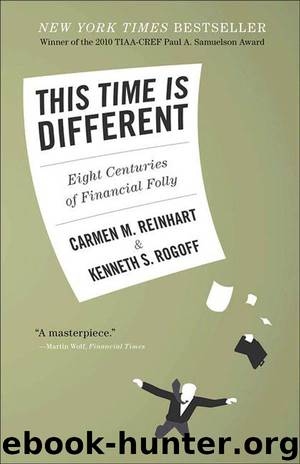This Time Is Different: Eight Centuries of Financial Folly by Reinhart Carmen M. & Rogoff Kenneth

Author:Reinhart, Carmen M. & Rogoff, Kenneth [Reinhart, Carmen M.]
Language: eng
Format: mobi
Publisher: Princeton University Press
Published: 2009-09-11T04:00:00+00:00
- PART V -
THE U.S. SUBPRIME MELTDOWN AND
THE SECOND GREAT CONTRACTION
How relevant are historical benchmarks for assessing the trajectory of a modern global financial crisis? In this part of the book we draw on our historical data set to develop benchmarks for measuring the severity of the crisis in terms of both the run-up to it and the possible evolution of its aftermath. A few years back, many people would have said that improvements in financial engineering and the conduct of monetary policy had done much to tame the business cycle and limit the risk of financial contagion. But the recent global financial crisis has proven them wrong.
When the “subprime financial crisis” (as it was initially called) began to unfold in the summer of 2007, a cursory reading of the global financial press would have led one to conclude that the world economy was moving through dark and uncharted waters. Indeed, after events took a decided turn for the worse in the early fall of 2008, much of the commentary took on an apocalyptic tone usually reserved for a threat that could potentially end civilization (as we know it). Yet, had policy makers looked at the recent history of financial crises, they would have found that it provided an important qualitative and quantitative perspective on how to gauge the evolution of the crisis.
In the next four chapters we will attempt to do exactly that, drawing on past experiences for analogies and making use of our data set to establish quantitative benchmarks. Because many of our readers may want to begin with the most recent crisis, we have done our best to make this part of the book relatively self-contained, reviewing and repeating main themes from earlier chapters as necessary.
In the first of these chapters, chapter 13, we will begin with an overview of the history of banking crises that is tailored to give the reader a perspective of the current crisis. We will pay particular attention to the debate on the massive global current account imbalances that preceded the crisis and, some would say, helped trigger it. As we will show, the outsized U.S. borrowing from abroad that occurred prior to the crisis (manifested in a sequence of gaping current account and trade balance deficits) was hardly the only warning signal. In fact, the U.S. economy, at the epicenter of the crisis, showed many other signs of being on the brink of a deep financial crisis. Other measures such as asset price inflation, most notably in the real estate sector, rising household leverage, and the slowing output—standard leading indicators of financial crises—all revealed worrisome symptoms. Indeed, from a purely quantitative perspective, the run-up to the U.S. financial crisis showed all the signs of an accident waiting to happen. Of course, the United States was hardly alone in showing classic warning signs of a financial crisis, with Great Britain, Spain, and Ireland, among other countries, experiencing many of the same symptoms.
In the next chapter, chapter 14, we will extend the comparison between the past crises and the recent one by examining the aftermath of severe financial crises.
Download
This site does not store any files on its server. We only index and link to content provided by other sites. Please contact the content providers to delete copyright contents if any and email us, we'll remove relevant links or contents immediately.
International Integration of the Brazilian Economy by Elias C. Grivoyannis(74744)
The Radium Girls by Kate Moore(11621)
Turbulence by E. J. Noyes(7700)
Nudge - Improving Decisions about Health, Wealth, and Happiness by Thaler Sunstein(7242)
The Black Swan by Nassim Nicholas Taleb(6763)
Rich Dad Poor Dad by Robert T. Kiyosaki(6174)
Pioneering Portfolio Management by David F. Swensen(6078)
Man-made Catastrophes and Risk Information Concealment by Dmitry Chernov & Didier Sornette(5646)
Zero to One by Peter Thiel(5488)
Secrecy World by Jake Bernstein(4388)
Millionaire: The Philanderer, Gambler, and Duelist Who Invented Modern Finance by Janet Gleeson(4094)
The Age of Surveillance Capitalism by Shoshana Zuboff(3983)
Skin in the Game by Nassim Nicholas Taleb(3965)
The Money Culture by Michael Lewis(3846)
Bullshit Jobs by David Graeber(3830)
Skin in the Game: Hidden Asymmetries in Daily Life by Nassim Nicholas Taleb(3722)
The Dhandho Investor by Mohnish Pabrai(3560)
The Wisdom of Finance by Mihir Desai(3523)
Blockchain Basics by Daniel Drescher(3329)
